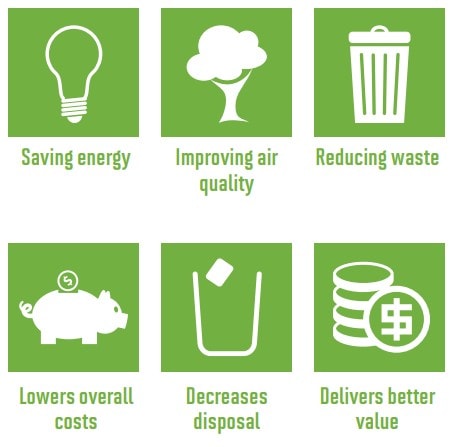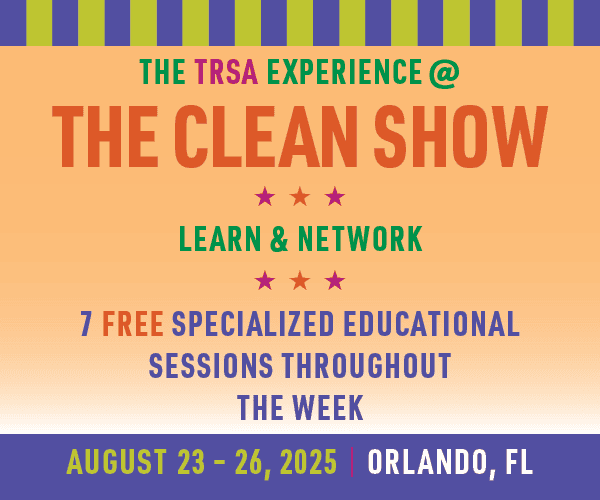About Shop Towels
TRSA has compiled shop towel-related resources including research, best practices and reusable vs. disposable comparisons to help members retain business. In addition, TRSA has posted a toolkit to comply with the EPA’s “Conditional Exclusions from Solid Waste and Hazardous Waste for Solvent-Contaminated Wipes; Final Rule” which codifies best practices for handling reusable shop towels including a list of frequently asked questions (FAQs) and other materials designed to help launderers, customers, employees, and route drivers to comply.
From the moment they are manufactured through their industrial use and disposal, reusables have less environmental impact than disposables and are more economical.
Compliance FAQs
The Solvent Contaminated Wipe Rule, or “Shop Towel Rule” was published on July 31, 2013, by the U.S. Environmental Protection Agency (U.S. EPA) to exempt “reusable wipes” (known in the industry as “shop towels” and “printer towels”) from regulation as solid waste so long as certain conditions are met. The rule enters into force on January 31, 2014.The rule revises the definition of “solid waste” under the Resource Conservation and Recovery Act (RCRA) to conditionally exclude from further regulation (as solid or hazardous waste) solvent-contaminated wipes that are cleaned and reused.
No. This rule only applies to solvent-contaminated wipes and then only to wipes that contain either:
- Only specific listed solvents OR
- Are ignitable due to the presence of solvents
Not every shop towel will meet that requirement. The exclusion does not extend to wipes contaminated with hazardous wastes other than solvents, or that exhibit the characteristics of toxicity, corrosivity, or reactivity due to other contaminants or non-listed solvents.
Many shop towels and printer wipes can cause VOC emissions and that should alert a facility to the likelihood that customers are returning the towels with solvents that may be subject to the regulation. It is probably a safe practice to assume that all shop towels and printer wipes are subject to the regulation and manage them accordingly. Facilities should confirm with their customers the types of solvents or other contaminants believed to be present on their shop towels.1 Listed solvents include: acetone, isobutyl alcohol, benzene, methanol, n-butanol , methyl ethyl ketone, chlorobenzene, methyl isobutyl ketone, creosols, methylene chloride, cyclohexanone, tetrachloroethylene, 1,2-dichlorobenzene, toluene, ethyl acetate, 1,1,2- trichloroethane, ethyl benzene, trichloroethylene, 2- ethoxyethanol, and xylenes.
The following conditions must be met for solvent-contaminated shop and printer towels that are sent for cleaning and reuse to be excluded from further RCRA regulation. Please consult the EPA regulations (40 C.F.R. §261.4(a)(26)) for full details.
- Storage: Wipes must be accumulated, stored, and transported in non-leaking, closed containers that can contain free liquids, should they occur. This applies at both the customer and laundry facilities, as well as during transport.
- Labeling: Containers must be labeled “Excluded Solvent-Contaminated Wipes.”
- Accumulation Time: Customers may accumulate wipes up to 180 days from the start date of accumulation prior to being sent for cleaning or disposal.
- No Free Liquids: Wipes must contain no free liquids at the point of transportation and there may not be free liquid in the container holding the wipes. “No free liquids” is determined by application of EPA’s Paint Filter Liquids Test (EPA Test Method 9095B) or an alternative authorized state standard.
- Management of Free Liquids: Free liquids removed from the wipes or from the wipes container must be managed according to applicable RCRA hazardous waste regulations. This applies to both the customer and laundry facilities.
- Eligible Handling Facility: Must go to a laundry or dry cleaner whose discharge, if any, is regulated under sections 301 and 402 or section 307 of the Clean Water Act.
- Record Keeping: Customers must maintain documentation that includes (i) name and address of the laundry or dry cleaner to which the wipes are sent; (ii) documentation that the 180-day accumulation time limit is being met; and (iii) description of the process the customer is using to meet the “no free liquids” condition.
Containers must be closed and capable of containing free liquids should they occur. The container material and design is not prescribed by the regulation. The container material, however, must be impermeable to liquid, no matter the material it is made from. The container should not show evidence of corrosion or other wear that could lead to escape of free liquids.
Containers must be capable of containing free liquids should they occur. Cloth, canvas, or propylene woven bags, if used, must be impermeable. The container also must be capable of sealing all openings tightly to prevent leaks or emissions.
No. Simply covering a container with plywood does not meet the closed container standard. A container is considered closed when there is complete contact between the fitted lid and the rim of the container, such as a container with a spring- loaded lid. When the container is ready for transport, it must be sealed with the lid properly and securely affixed to the container and all openings tightly bound or closed to prevent leaks or emissions.
The rule that does not specify how or where containers must be stored. Practically, containers for shop towel storage should be placed on a pallet or otherwise positioned so that they may be inspected to confirm that free liquids have not escaped.
This documentation can take many forms, including:
- A service contract or invoice from the laundry or dry cleaner which describes the frequency of scheduled delivery and pick-up of wipes
- A log that lists the start date of accumulation for each container of solvent-contaminated wipes
- Labels on each container which include the start date of accumulation (i.e., the date the first solvent-contaminated wipe is placed in the container).
The Paint Filter Liquids Test is identified in the Shop Towel Rule as the standard for determining if solvent-contaminated wipes meet the “no free liquids” requirement. The test, technically known as EPA Test Method 9095B, is designed to determine the presence of free liquids in a given sample material. To perform the test, a predetermined amount of the test material is placed in a paint filter. If any liquid passes through and drops from the filter within the 5 minute test period, the material is deemed to contain free liquids.
The test does not have to be performed on every solvent-contaminated wipe or at any particular time. Rather, the customer must ensure that if the test were performed, the shop towel would pass. Customers may use a variety of methods to remove solvent from the wipe to ensure that liquids are extracted, such as (but not limited to) centrifuging, mechanical wringing, screen bottom drums, microwave technology, or vacuum extraction.
At the time of transportation, the customer should provide the transporter with documentation of the process used to meet the “no free liquids” condition. The customer is required by the rule to maintain such documentation. This documentation only needs to be updated in the event that the customer changes its process for meeting the “no free liquids” condition. In addition to receiving the documentation, the transporter nevertheless should inspect the container for signs of free liquids (e.g., liquid visibly apparent in the container, sloshing of liquid, the presence of visibly wet towels, etc.). If free liquids are present, then the driver should request the customer to remove them and manage them in accordance with all appropriate hazardous waste regulations.
The rule recognizes that despite best efforts and compliance with the “no free liquids” condition at the time of transport, free liquid may nonetheless be generated during transport. This does not result in a violation of the rule, though it demonstrates why customers should document their efforts to comply with the “no free liquids” requirement.
If the laundry facility finds free liquids in a shop towel container, the facility is required to handle the free liquids in accordance with all hazardous waste regulations. The reusable wipes themselves remain under the exclusion provided that the conditions of the exclusion were met (i.e., the wipes and container were documented as not containing free liquids at the time of transport).
No. Users of disposable wipes still will have potential liability under Superfund or similar laws for releases of contaminants from the landfill. Reusable wipes do not have such liability for disposal because the wipes are recycled.
State hazardous waste programs are required to have rules at least as stringent as the applicable federal rule. Currently, 45 states have provided regulatory relief for solvent-contaminated reusable wipes, with about half providing an exclusion from the definition of solid waste, and the other half provided an exclusion from the hazardous waste regulations. The final EPA Shop Towel Rule is intended to provide a uniform set of conditions for such exclusions. When the EPA rule becomes effective after January 31, 2014, states will be free to adopt the federal rule or to maintain existing requirements (or impose new ones) that are at least as stringent as the federal standard.
Because the Shop Towel Rule includes requirements and conditions that are less stringent than those of the base RCRA hazardous waste program, states with an authorized RCRA program are not required to adopt the conditional exclusions (except as noted below). States may allow, through implementation of state waiver authorities or other state laws, compliance with the provisions of today’s rule in advance of adoption or authorization.
Some conditions required by the final Shop Towel Rule may be more stringent than the conditions under some existing state programs. As a result, authorized states whose programs include less stringent requirements than the federal Shop Towel Rule are required to modify their programs to maintain consistency with the federal program. In addition, any states that delineate their program for reusable wipes in guidance documents or interpretive letters will need to promulgate enforceable regulations. The current state requirements remain in place until the state adopts the equivalent to these federal requirements.
No. The Shop Towel Rule does not regulate or otherwise impact the disposal of sludge generated by wastewater treatment operations at laundry facilities. EPA examined the chemical characteristics of sludge as part of the risk assessment analysis of the rulemaking. That analysis was used to justify and shape the criteria for the exclusion for properly managed reusable solvent-contaminated wipes. However, the rule does not alter the rules related to disposal of the sludge.
The rule requires customers to ensure that reusable wipes contain no free liquids, but does not otherwise require reusable wipes to be treated to remove solvents. Therefore, solvent-contaminated reusable wipes may still contain solvents that can cause VOC emissions when the wipes are processed at a laundry facility. The rule itself does not address issues associated with air emissions at laundry facilities.
There are three main differences between the exclusion for reusable wipes and the exclusion for disposable wipes.
First, under the rule, reusable solvent-contaminated wipes that meet the criteria for the exclusion are neither solid nor hazardous wastes. In contrast, disposable wipes are still considered solid wastes, but not hazardous wastes.
Second, disposable wipes that are hazardous waste due to the presence of trichloroethylene (TCE) are not eligible for the exclusion. This is because EPA’s final risk analysis demonstrated that wipes contaminated with TCE may pose a significant risk to human health and the environment when disposed in a lined landfill.
Third, reusable wipes are allowed to be sent to laundries or dry cleaners whose discharge, if any, is regulated under the Clean Water Act. In contrast, disposable wipes may go to one of the following options:
- Combustors that are regulated under the Clean Air Act or RCRA
- Municipal solid waste landfills
- Hazardous waste landfills.
TRSA is tracking the state adoption of the Rule. However, there are a number of States that have regulations incorporating by reference the EPA rules. For those states, further action at the state level is not necessary. Other states will have to amend their existing rules.
Typically it can take states a year or more after a new EPA rule goes into effect to make the necessary changes. Because the EPA rule will become the minimum requirement in all states, it does make sense for the companies to start putting compliance programs in place (labeling, container requirements, etc.) even in states that have not yet adopted the EPA rule.
Shop Towel Resources
Shop Towels – Environmentally Friendly
This TRSA advocacy brochure features findings from the Comparative Life Cycle Assessment…
Shop Towels Best Practices
TRSA members are dedicated to safe, sustainable and cost-effective business practices. Their…








